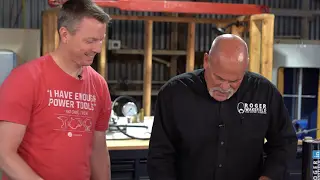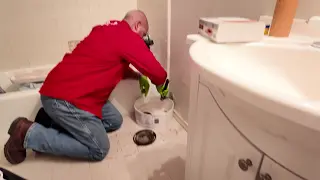On the surface, bending your own pipe and forming hubs might seem like a cost-saving trick—especially if you’ve stumbled across internet videos claiming it’s easy. But as you’ll discover in this post, the risks of hot, softening plastic and the potential for damaging or weakening the pipe can far outweigh any perceived convenience.
In this blog, we’ll dig into the details of the PVC “hack,” walk through our own attempt at replicating it, and explain why you should steer clear of this approach. We’ll also give you the facts about PVC, review the health and safety concerns, and explain what works better in a real-world plumbing environment. If you’re a DIY enthusiast or a professional looking to avoid disasters, read on before you attempt to bend or shape PVC with open flames.
Why People Try the “No-Fitting” PVC Hack
PVC (polyvinyl chloride) is a widely used plastic material commonly seen in residential, commercial, and industrial plumbing. It’s relatively easy to cut, lightweight, and resistant to corrosion. Still, using PVC properly involves selecting the right diameter, schedule (thickness), fittings, primer, and cement.
When people see a “quick hack” online showing a pipe heated over an open flame (like a candle, torch, or small burner) to form new shapes, it can seem appealing for a few reasons:
- Fewer Fittings: Elbows, tees, and couplings do cost money. Bending or reshaping pipe might seem like a cheaper solution.
- Reduced Installation Complexity: Instead of gluing a series of fittings, you’d theoretically have fewer or no joints.
- Creative Freedom: For DIYers, shaping PVC into custom angles or designs might look like an interesting craft project.
However, plumbing hacks can often be misleading, and what appears to be “saving money” can cause hidden hazards or code violations. As you’ll see, there’s more to the story than just avoiding a trip to the hardware store for an elbow.
Our Attempt to Replicate the Hack
In the viral video, the creator shows themselves heating the end of a PVC pipe to form a bell (or “hub”). Meanwhile, they also appear to be bending PVC to certain angles—apparently without scorching or weakening the material. We tried to copy their method, complete with a small camp burner and one-inch Schedule 40 PVC.
What We Used
- One-inch Schedule 40 PVC (a common type used for water supply or irrigation).
- A camp burner running on standard canister fuel (similar to an outdoor camping stove).
- Assorted gloves, from latex to leather, to protect our hands.
- A well-ventilated area to keep potential fumes away—though you should note this process can release toxic fumes if the PVC overheats.
Step-by-Step Heating
- Positioning the Pipe: We placed the PVC pipe carefully over the flame, keeping it a few inches above to avoid immediate scorching.
- Rotating Constantly: Similar to roasting marshmallows, we tried to heat the pipe evenly. The moment we allowed any portion to linger, the pipe began to blacken or bubble, signaling it was burning rather than softening uniformly.
- Wearing Gloves: While some videos show the user holding the pipe barehanded, the plastic becomes extremely hot. Our latex gloves risked melting. We had to switch to heavy-duty leather gloves for better protection.
- Forming the End: After prolonged heating, the idea was to press or shape the softened PVC into a widened “hub.” In practice, the pipe’s integrity became questionable: it discolored, started smelling, and felt pliable in ways that suggested structural compromise.
Results and Observations
- Slow Heating Process: Even with a camp burner, it took a significant amount of time to heat the PVC enough to shape it. Using a candle—another variant of this hack—would be even slower and more uneven.
- Burnt Plastic Smell: That signature acrid odor indicated we were nearing a point where the pipe’s material could be degrading.
- Melting Hazards: Edges of the PVC can bubble or drip when overheated. This can lead to burns on skin, or even ignite surrounding materials if you’re not in a controlled setup.
- Damage to Pipe Integrity: Once the pipe is overheated, it’s no longer trustworthy for pressurized water or structural use. In plumbing, reliability is everything—you don’t want to guess if your pipe can handle normal water pressure after it’s been scorched.
Ultimately, the moment we tried to create a true “hub,” the pipe began collapsing, losing its round shape and forming lumps. The inside diameter didn’t remain smooth, which can restrict flow and trap debris. Realistically, this pipe would be a prime candidate for leaks, cracks, or blowouts down the road.
The Dangers of Heating PVC
PVC is thermoplastic, meaning it softens upon heating and can be reshaped. However, it has specific temperature thresholds. Once you get beyond certain points (often around 200–250°F for shaping, but well before it blackens), you start breaking down the PVC’s chemical structure.
Toxic Fumes
When PVC burns or is superheated, it can release hydrogen chloride gas, dioxins, and other harmful chemicals. These fumes irritate the eyes, nose, and throat. In extreme cases, prolonged exposure can lead to more severe respiratory damage.
Structural Weakness
PVC used in plumbing is rated to handle certain pressures and temperatures based on its design. Overheating can create micro-fractures or thin spots, weakening the pipe drastically. If that pipe is later subjected to even moderate water pressure, you risk leaks or bursts.
Fire Hazards
Open flames, like a camp burner or candle, introduce a whole new risk in any setting. PVC can ignite or drip molten plastic. In tight spaces, this is extremely dangerous and a major code violation. Professional plumbers use heat guns or specialized bending tools under very controlled conditions. Even then, the focus is typically on conduit or in low-pressure applications—not main water lines.
Why You Should Use Fittings Instead
The short answer: Fittings exist for a reason. They’re typically injection-molded, tested, and standardized to fit snugly with your pipe diameter. When used with primer and solvent cement, properly installed fittings create a durable, leak-resistant joint.
Reliable, Code-Compliant Joints
Almost all building codes require plumbing systems to follow certain guidelines. Joints must be made with recognized fittings and methods that have been tested for safety and durability. A “hand-molded” PVC fitting from a blowtorch or candle does not meet any recognized standard.
Time and Cost
While you might think you’re saving money by skipping elbows or couplings, each fitting typically costs a couple of dollars at most. Considering the time it took us to heat one piece of pipe, you could have driven to the store or placed an online order for the correct fitting and still come out ahead. Plus, you wouldn’t risk personal injury or a meltdown of your pipe.
Consistent Flow and Capacity
Plumbing fittings maintain the proper interior diameter for water flow. When you deform a PVC pipe by hand, the inside becomes uneven. Flow rates can drop, and you might experience more friction or blockages. In high-efficiency systems, such small irregularities can result in big performance issues.
Common Scenarios Where This “Hack” Might Appear
- Outdoor Projects: Garden or irrigation lines, where someone wants a gentle bend in the pipe. Even though it’s low-pressure, it’s still risky.
- DIY Crafts: People sometimes shape PVC for arts, greenhouse hoops, or decorative structures. While less critical than potable water lines, the risk of inhaling fumes or causing a fire still exists if you’re doing it in your living room or garage.
- Emergency Repairs: In a pinch, a homeowner might think, “I don’t have a 90° elbow, but I have a lighter.” This approach could patch a temporary fix, but it’s not recommended or code-approved in any capacity.
Alternatives for Bending PVC
If you absolutely must create a curve or shape in PVC pipe, consider the following legitimate methods:
- PVC Conduit Benders: Electricians use these for non-metallic conduit. They’re specifically designed to heat the pipe more evenly and avoid scorching. However, these are often used for electrical conduit, not necessarily pressurized water lines.
- Heat Guns and Bend Springs: A heat gun can be used with a special internal spring that helps maintain the pipe’s internal diameter. This is occasionally done for gentle sweeps in irrigation lines. But it must be done carefully, and typically it’s still not recommended for high-pressure lines.
- Flexible PVC: For certain irrigation or drainage projects, you can buy flexible PVC or PE (polyethylene) piping that’s designed to bend around corners. This is less likely to crack and is often rated for moderate pressures.
Why the Viral Video Attracts Viewers
It’s no surprise the original hack video gained millions of views. People love simple, visually striking solutions—especially if it promises to eliminate a trip to the hardware store. Watching a pipe go from rigid cylinder to shapable material can be mesmerizing. It’s akin to seeing a life hack that looks too good to be true.
Unfortunately, many viral hacks either skip showing the failures or don’t mention the hazards. The thumbnail might show a perfectly formed pipe hub or a smooth 90° bend, but the steps to get there are fraught with risk and typically not replicable in real-world conditions.
The Real Hack: Using the Right Parts and Tools
True plumbing “hackers” (in the sense of skilled professionals) know that the best approach is to:
- Plan your layout properly.
- Gather the right fittings—elbows, couplings, tees, etc.
- Use primer and solvent cement correctly for leak-free joints.
- Follow local plumbing codes and best practices.
- Test your system for leaks under safe conditions, not with a blowtorch in your kitchen.
That’s the real shortcut to success: Doing it by the book the first time so you don’t face repairs, fines, or dangerous blowouts later.
Key Takeaways from Our PVC FAIL
- Heating Over Open Flame Isn’t Wise: The pipe gets too hot too quickly, releasing fumes and risking structural failure.
- PVC Doesn’t Tolerate Overheating: It will degrade or burn if taken beyond safe shaping temperatures.
- Missing Safety Gear: Some viral videos skip gloves or mention ventilation. We found that gloves were essential, and even then, the risk of burns was high.
- Hub Formation Is Unstable: Attempting to create a built-in hub often leads to lumps, uneven walls, and possible micro-cracks.
- Commercial Fittings Are Cheap and Reliable: An elbow or coupling might cost a couple of bucks, but it saves you from so much grief.
If you’re a homeowner, it’s worth the small investment to buy the right parts or hire a professional for your plumbing installation. And if you’re a tradesperson, you already know that shortcuts in plumbing typically mean having to revisit the job to fix avoidable problems.
So the next time you see a flashy internet hack for heating and bending PVC or making a “hub” without a fitting, remember our meltdown experience. You’ll save yourself time, money, and potential hazards by sticking to tried-and-true plumbing methods—real hacks that actually work in the long term.




